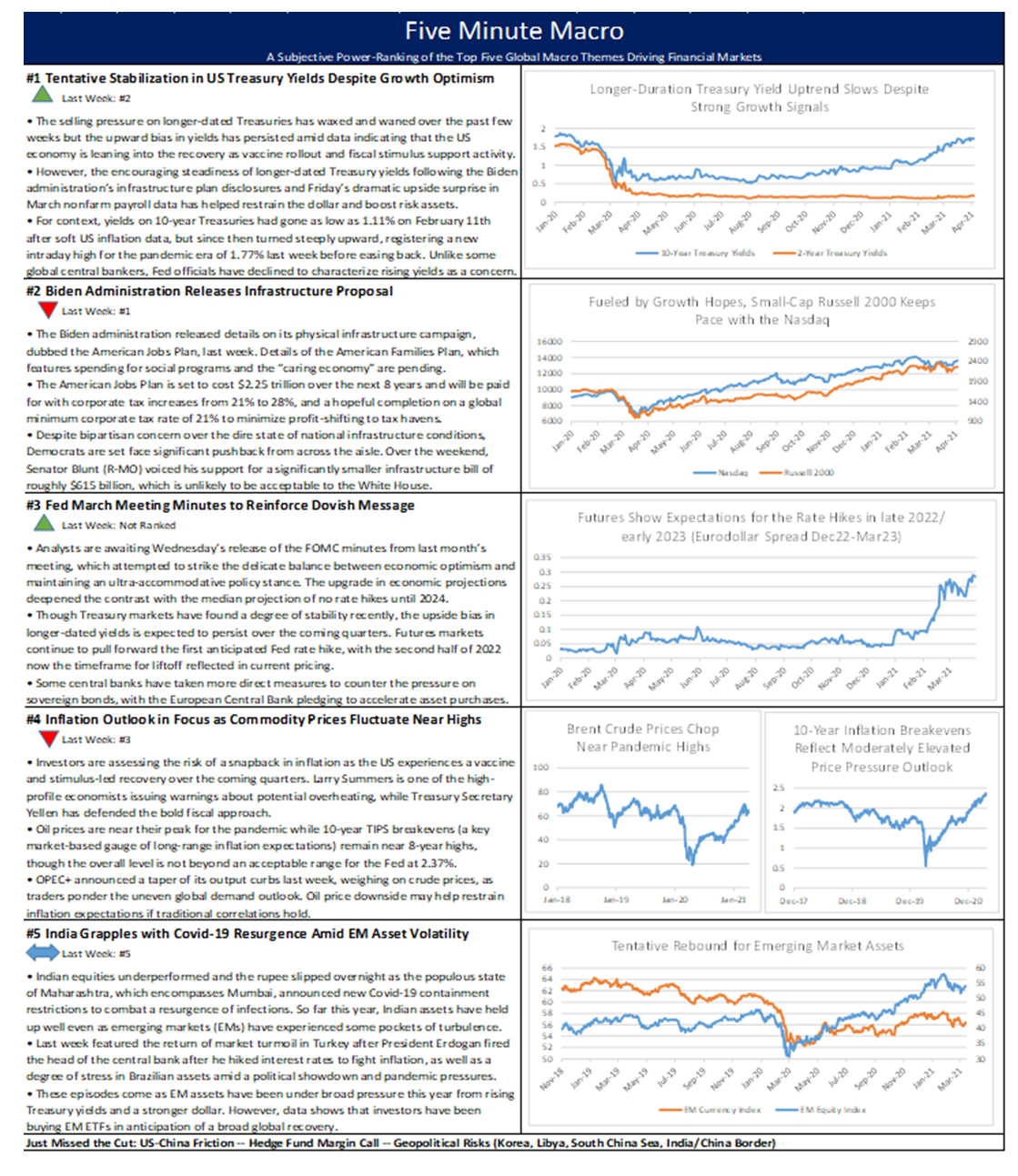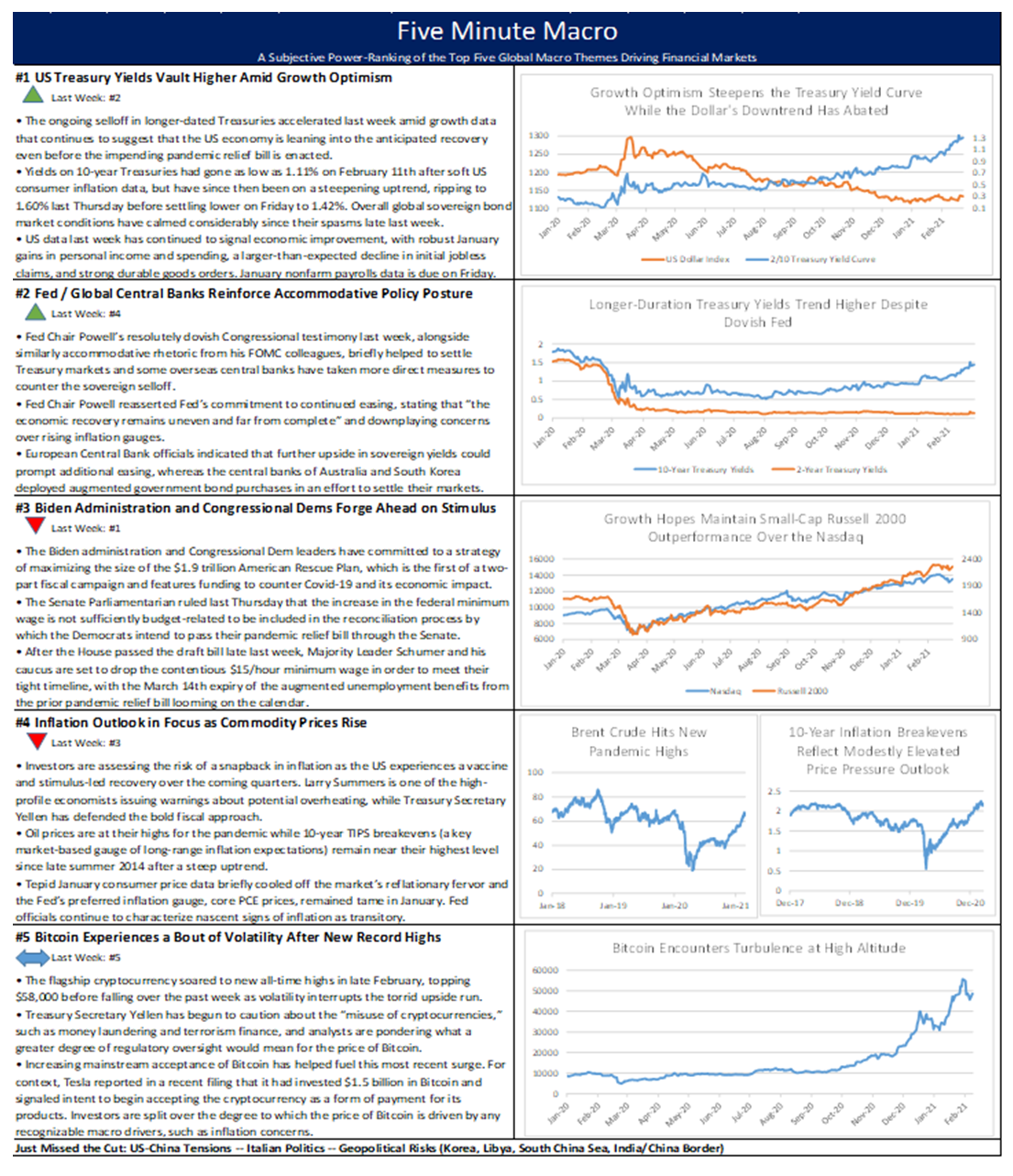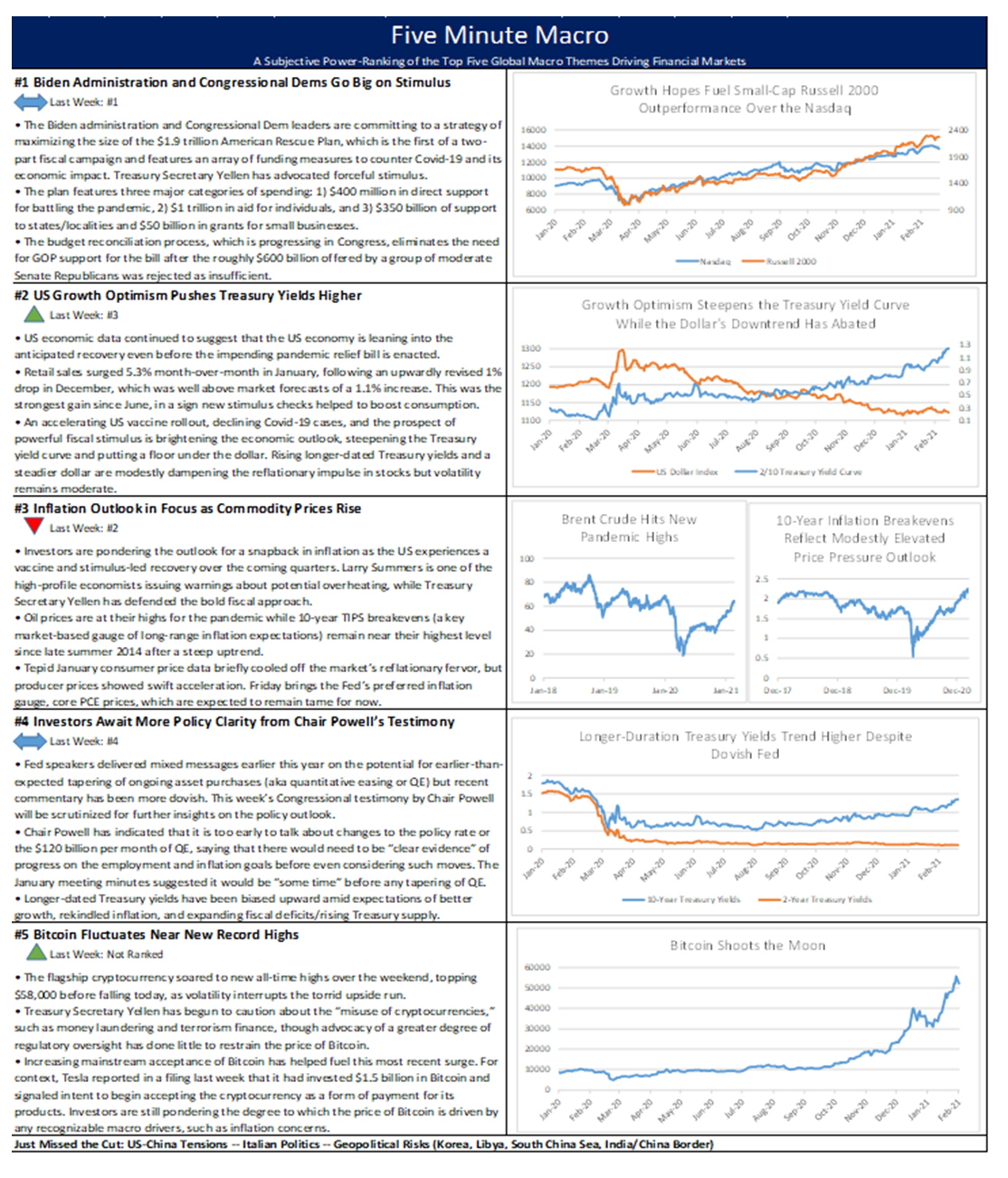Looking Ahead – Procedural Thriller
Please join us today at 2:30 PM ET for a call on the Biden Administration’s American Jobs Plan spending proposals and accompanying tax increases. We will be joined by our colleagues at Hamilton Place Strategies, Meghan Pennington and Bryan DeAngelis. Both have extensive experience on Capitol Hill and will have insights on the reconciliation process, as well as perspective on what elements are likely to make their way into the final bill and what may not have the votes. We will also touch on other themes, like US corporations being embroiled in politics, whether over voting rights, pay/unions, taxes, etc.
Please reply to Jeff Easter (jeff.easter@marketspolicy.com) if you would like to join the call.
Some of the key questions we will be pondering are as follows:
The Biden administration has split this massive legislative campaign into two main fronts – physical infrastructure (the American Jobs Plan) and social programs/caring economy (the yet-to-be unveiled American Families Plan). The total price tag of the combined proposals is estimated to be around $4 trillion. What is the reason for this bifurcated approach?
Related to question 1 above, what is the importance of this week’s ruling by the Senate Parliamentarian, which indicated that Democrats could utilize budget reconciliation an additional time to bypass Republican support with a simple Senate majority. The ruling permits Democrats to revisit the fiscal 2021 budget resolution that Congress used to approve the $1.9 trillion relief bill earlier this year, in effect creating three opportunities to use reconciliation to pass a significant portion of the administration’s economic agenda before the midterm elections in 2022.
Related to question 2 above, if the Biden administration goes for an omnibus approach to this next bill, what might they use their third and final budget reconciliation procedure for later this year?
How does this physical infrastructure bill cut across party lines? Is there any hope of a bipartisan segment, such as a smaller infrastructure package free of tax hikes that would potentially draw out some GOP support? Would that be worth doing from a political and policy standpoint?
Senator Manchin has come out with some strong statements on the current American Jobs Plan draft, pushing back on the increase in corporate taxes to 28% and expressing a preference for 25%, while indicating that he is uncomfortable with the overall size of the package and favors a more bipartisan approach. He has a lot of political capital, but does he have enough to truly steer this bill in a radically different direction if in fact that is what he wants to do?
So much of the focus is on what Senator Manchin wants, but with such a slim majority in the House, will the Blue Dog contingent have a similar power over what makes it in?
Looking ahead to next week, the macro calendar features some consequential global economic data, with US consumer price inflation figures in sharp focus, while March retail sales and industrial production for the US and EU could highlight their diverging economic fortunes. Economic sentiment gauges for the US, Germany, and Australia are also due, alongside first quarter Chinese GDP and key growth metrics for March.
- US Consumer Price Inflation
- US & EU Retail Sales
- US & EU Industrial Production
- Chinese GDP and March Data
- US Initial Jobless Claims
- Global Economic Sentiment Surveys
Global Economic Calendar: In bloom
Monday
Eurozone’s retail trade slumped 5.9% m/m in January, the steepest decline since last April’s record slump and compared with market expectations of a 1.1% drop, as a number of member states re-imposed or extended coronavirus lockdown measures. Non-food products sales plunged 12%, despite a 7.1% increase in on-line trade, while fuel sales were down 1.1%. Meanwhile, food, drinks and tobacco trade rose 1.1%, compared with a 2.3% growth in December. On a yearly basis, retail sales shrank 6.4% , also the largest decrease since April.
The NAB business confidence index in Australia rose 4 points from the previous month to 16 in February 2021, its highest level since early 2010, with all states and industries reporting gains, except for retail. In addition, the gauge measuring business conditions climbed 6 points to 15, matching the December reading, which was the highest level since August 2018, with all three sub-components improving: trading, profitability and employment. Meantime, capacity utilization and capex continue to rise and have now exceeded pre-virus levels and their long-run averages. Forward orders also rose and are now well above average. “Business conditions and confidence are both at multi-year highs and, importantly, we’re starting to see an uptrend in business hiring and investment activity.” said Alan Oster, NAB Group Chief Economist.
Chinese Balance of Trade showed a trade surplus of $103.25 billion in January-February 2021 combined, rebounding sharply from a $7.21 billion deficit in the same period a year earlier, and easily beating market consensus of a $60 billion surplus, as the economy recovered from the disruption caused by COVID-19, with more factories resuming their production. Exports surged 60.6% y/y, the eighth straight month of increase, while imports rose at a softer 22.2%, the fifth consecutive month of growth. China’s trade surplus with the US for the first two months of the year stood at $51.26 billion, much larger than a surplus of $25.37 billion in the corresponding period a year earlier. To smooth distortions due to the Lunar New Year festival, Chinese customs combine January and February trade data.
Tuesday
The UK Balance of Trade showed the trade deficit fell to £1.6 billion in January, the smallest trade shortfall in five months, as both imports and exports fell at a record pace following the end of EU exit transition period and the reintroduction of COVID-19 restrictions on activity. Imports declined 18.5% to £43.03 billion, with purchases of goods slipping 22.8% and services imports falling 2.4%. Meantime, exports fell at a record 11.2% to £41.40 billion, as goods shipments slumped 18.3% and services sales decreased 0.9%.
The ZEW Indicator of Economic Sentiment for Germany rose by 5.4 points from the previous month to 76.6 in March, not far from September’s 20-year high of 77.4 and slightly above market expectations of 74.0. Optimism surrounding the economic outlook continued to improve, with investors anticipating a broad-based recovery of the German economy and at least 70 percent of the population to be offered a COVID-19 vaccine by autumn. In addition, the survey showed inflation is seen increasing further and long-term interest rates are forecast to be higher.
The Consumer Price Index (CPI) increased 0.4% m/m in February, slightly higher than 0.3% in January but matching market forecasts. The gasoline index continued to increase, up 6.4%, accounting for over half of CPI gain. The electricity, and natural gas indexes also increased and the energy index rose 3.9%. The food index edged up 0.2%. This pushed annual CPI up to 1.7% from 1.4% in January, and in-line with market forecasts of 1.7%. Core CPI, which excludes food and energy, inched up 0.1%, less than forecast of 0.2%, with increases seen in cost of shelter, recreation, medical care, and motor vehicle insurance while falls were seen for airline fares, used cars and trucks and apparel. Annual Core CPI, rose 1.3%, the least since June 2020 and missing expectations of a 1.4% advance.
The Westpac-Melbourne Institute Index of Consumer Sentiment increased by 2.6% to 111.8 in March, just 0.2 points below the December level which was a ten-year high driven by are improving economic conditions and prospects, both domestically and abroad, particularly as they relate to our labor market. Australia’s success in containing COVID-19, the promise of vaccine rollouts bringing an end to the pandemic, and support from stimulatory government policies have all contributed to the sustained lift. All components of the index were higher in March. Confidence around the economic outlook led the gains with the ‘economy, next 12 months’ sub-index up 3.7% and the ‘economy, next 5 years’ sub-index up 2.3%.
Wednesday
Industrial production in the Eurozone rose 0.8% m/m in January, rebounding from a downwardly revised 0.1% fall in December and compared with market expectations of a 0.2% increase. Output of durable consumer goods, such as televisions and washing machines, rose 0.8%, after a 0.9% advance in the previous month. Production also grew for non-durable consumer goods, capital goods, energy and intermediate goods. On a yearly basis, industrial production was up 0.1% in January, ending a 26-month period of contraction and compared with forecasts of a 2.4% decline.
US Import prices increased 1.3% m/m in February, easing from an upwardly revised 1.4% rise in January, which was the largest monthly advance since March 2012. Still, the reading came in above market expectations of 1.2%. Nonfuel import prices increased 0.4%, due to higher prices for nonfuel industrial supplies and materials; foods, feeds, and beverages; capital goods; consumer goods; and automotive vehicles. Meantime, prices for import fuel advanced 11.1%, the most since July 2020, mainly due to an 11.3% rise in petroleum prices and an 11.2% advance in natural gas prices. Year-on-year, import prices jumped 3%, the most since October 2018 as petroleum cost surged.
US Export Prices rose 1.6% m/m in February, after a 2.5% advance in January which was the largest increase since records began in December 1988. It also compared with market expectations of a 0.9% gain. The price index for agricultural exports rose 2.9% and nonagricultural export prices rose 1.5%. Year-on-year, export prices jumped 5.2% in February, the largest over-the-year increase since June 2018.
The Australian Employment Report showed the seasonally adjusted unemployment rate fell to 5.8% in February from 6.4% a month earlier and below market consensus of 6.3%. This was the lowest jobless rate since March 2020, as the economy recovered further from the disruption caused by the COVID-19 shocks. The number of unemployed declined by 69,900 to 805,200 people, as people looking for full-time work was down by 39,800 to 576,700 and those looking for only part-time work decreased by 30,100 to 228,500. Employment grew by 88,700 to a one-year high of 13,006,900, easily beating market estimates of an increase of 30,000, as full-time employment went up by 89,100 to 8,895,000, while part-time employment dropped 500 to 4,111,900. The participation rate stayed at 66.1% and below forecasts of 66.2%. The underemployment rate rose 0.4 points to 8.5%, and the underutilization rate fell 0.1 points to 14.4%. Monthly hours worked in all jobs gained 102 million hours, or 6.1% to 1,767 million hours.
Thursday
US Retail sales shrank 3% m/m in February, following an upwardly revised 7.6% jump in January and much worse than market forecasts of a 0.5% fall. It is the biggest decline since a record drop in April of 2020 amid unusually cold weather and winter storms in Texas and some other parts of the South region during the month. Biggest decreases were seen in sales at department stores, sporting goods, hobby, musical instruments and book stores, non-store retailers, auto dealers, furniture, miscellaneous retailers, building material and garden equipment, clothing, food services and drinking places, electronics and appliances and health and personal care. In contrast, sales at gasoline stations jumped 3.6%. Retail Sales Excluding Autos decreased 2.7% m/m, much worse than forecasts of a 0.1% fall, amid unusually cold weather in the South.
Initial and Continuing Claims will be in focus after the latest reading featured another disappointing degree of deterioration. Last week, the number of Americans filing for unemployment benefits rose for the second straight week, after a surprise drop to 658 thousand in late March, up to 744 thousand, from the previous period’s revised figure of 728 thousand, and well above market expectations of 680 thousand. The weekly report followed on the heels of news last week that that nonfarm employment rose by 916 thousand in March, the most in seven months, while the number of job openings hit their highest level in two years in February. In total, 18.164 million Americans received some sort of federal assistance, down slightly from 18.215 million.
Industrial production slumped 2.2% m/m in February, following an upwardly revised 1.1% growth in the previous month and missing market expectations of a 0.3% increase. It was the steepest contraction in industrial output since April’s record 12.7% slump, due to the severe winter weather in the south-central region of the country in mid-February. Most notably, some petroleum refineries, petrochemical facilities, and plastic resin plants suffered damage from the deep freeze and were offline for the rest of the month. Manufacturing output and mining production fell 3.1% and 5.4%, respectively, the utilities output increased 7.4%.
The NAHB housing market index fell 2 points to 82 in March compared to forecasts of 83. It is the lowest reading in 7 months amid rising interest rates and building materials costs, especially lumber. Current sales conditions for the single-family segment fell 3 points to 87 while sales expectations in the next six months increased 3 points to 83. Also, the prospective buyers’ sub-index was unchanged at 72.
Business inventories went up 0.3% m/m in January, in line with market expectations and easing from an upwardly revised 0.8% growth in December. It was the seventh consecutive month of gains in business inventories. Stocks at manufacturers edged up 0.1%, slowing from a 0.3% advance in the previous month and inventories at retailers fell 0.5%, down from a 1.7% rise. Meantime, stocks at wholesalers rose faster. Year-on-year, business inventories dropped 1.8%.
China’s fixed-asset investment (FAI) surged 35% y/y to CNY 4.52 trillion in January-February 2021, accelerating from a 2.9% advance in 2020 but below market consensus of a 40% growth, as the economy continued to recover from the pandemic crisis. Public investment jumped 32.9% and private investment soared by 36.4%. Investment in the primary industry grew 61.3%, and that in the tertiary industry expanded 34.6% boosted by transport, storage & postal industry; water conservancy, environment and public facilities management industry; education; health and social work; and culture, sports and entertainment industry. Also, investment in the secondary industry jumped 34.1%. In January-February 2020, fixed-asset investment had plunged by a record 24.5% due to the coronavirus pandemic.
China’s 1st Quarter GDP will be released. China has set its 2021 economic growth target at more than 6%, Premier Li Keqiang said in his annual work report on Friday. Chinese leaders announced that the world’s second-largest economy intends to keep consumer price inflation at around 3% and seeks a budget deficit goal of about 3.2% of GDP. The government also aims for an urban unemployment rate of approximately 5.5% and plans to create more than 11 million new urban jobs. In 2020, the country’s GDP expanded 2.3%, the slowest pace in more than four decades.
Friday
Eurozone’s trade surplus widened to €6.3 billion in January from €1.6 billion in the corresponding month of the previous year. Still, it was the smallest trade surplus since last April, linked to the reintroduction of coronavirus restrictions in several European countries. Imports declined 14.1% from a year earlier to a five-month low of €156.8 billion. China was the main partner for the EU due to an increase of exports while imports decreased. Trade with the US recorded a significant drop in both imports and exports.
The Eurozone consumer price index is expected to accelerate to 1.3% y/y in March, the highest level since January 2020 and in line with market expectations, a preliminary estimate showed. Energy prices should rebound 4.3%, compared with a 1.7% drop in February, and services inflation is seen picking up to 1.3% from 1.2%. Meanwhile, cost will probably rise at a slower pace for both non-energy industrial goods and food, alcohol & tobacco. The annual core inflation, which excludes volatile prices of energy, food, alcohol & tobacco and at which the ECB looks in its policy decisions, is expected to slow to 0.9% in March, below market forecasts of 1.1%.
US Housing starts sank 10.3% m/m to an annualized rate of 1.421 million in February, the lowest reading in six months and well below forecasts of 1.56 million. Housing starts reached the highest rate in 14 years in December as people moved away from the big cities due to the coronavirus pandemic. In February, single-family housing starts were at a rate of 1.040 million, 8.5% below January and the rate for units in buildings with five units or more dropped 14.5% to 372,000. Starts fell in the Northeast, the Midwest and the South but rose in the West.
Building permits tumbled 10.8% m/m to a seasonally adjusted annual rate of 1.682 million in February, down from the previous month’s 15-year high of 1.886 million and below market expectations of 1.75 million. Single-family authorizations plunged 10.0% to a rate of 1.143 million while permits for the volatile multi-segment dropped 12.5% to a rate of 539 thousand. Across regions, permits went down in the South, the West, and the Northeast. Meanwhile, building permits in the Midwest rose 1.2% to 249 thousand.
The University of Michigan’s consumer sentiment was revised higher to a one-year high of 84.9 in March of 2021, up from a preliminary estimate of 83 and above market forecasts of 83.6. It was also the largest increase in consumer morale since May 2013, as households welcomed the third disbursement of relief checks and a better than anticipated vaccination progress. Meanwhile, expectations were revised higher to 79.7 from 77.5 and compared to February’s 70.7. The current conditions gauge rose to 93, above a preliminary of 91.5 and up from February’s 86.2. Inflation expectations for the year ahead decreased to 3.1% from 3.3% in the previous month, matching initial figures; while the 5-year outlook rose to 2.8% from 2.7%, above preliminary figures of 2.7%. “The data clearly point toward robust increases in consumer spending.”







